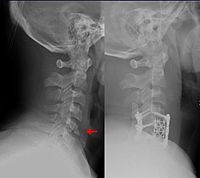
Photo from wikipedia
OBJECTIVES To determine the infection and non-union rates for open tibia fracture treatment over the last four decades since the introduction of the Gustilo-Anderson (GA) open fracture classification. DATA SOURCES… Click to show full abstract
OBJECTIVES To determine the infection and non-union rates for open tibia fracture treatment over the last four decades since the introduction of the Gustilo-Anderson (GA) open fracture classification. DATA SOURCES PubMed, Scopus, CINAHL, and Cochrane databases were reviewed using the PRISMA checklist for articles between 1977 and September 2018. STUDY SELECTION 161 articles meeting the following inclusion criteria: English language, published between 1977-2018, reported infection rates, reported nonunion rates and fractures classified by the GA open fracture criteria were selected. DATA EXTRACTION All articles were thoroughly evaluated to extract infection and nonunion data for open tibia fractures.Data Synthesis Due to variability in the data reviewed, statistical evaluation could not be reliably done. RESULTS 11,326 open tibia fractures were reported with 17% type I, 25.2% type II, 25.3% type IIIA, and 32.5% type IIIB/C. The average infection rate over four decades was 18.3%, with 24.3% superficial, 61% deep, and 14.7% pin tract. The infection rate by decade was: 14% for 1977-1986, 16.2% for 1987-1996, 20.5% for 1997-2006, and 18.1% from 2007-2017. The overall non-union rate was 14.1%. The non-union rate was 13% for 1977-1986, 17% for 1987-1996, 12.8% for 1997-2006, and 12.3% for 2007-2017. CONCLUSIONS This in-depth summary has demonstrated that the percentage rate for infections and nonunion has remained similar over the past forty years. LEVEL OF EVIDENCE Level IV. See Instructions for Authors for a complete description of levels of evidence.
Journal Title: Journal of orthopaedic trauma
Year Published: 2023
Link to full text (if available)
Share on Social Media: Sign Up to like & get
recommendations!